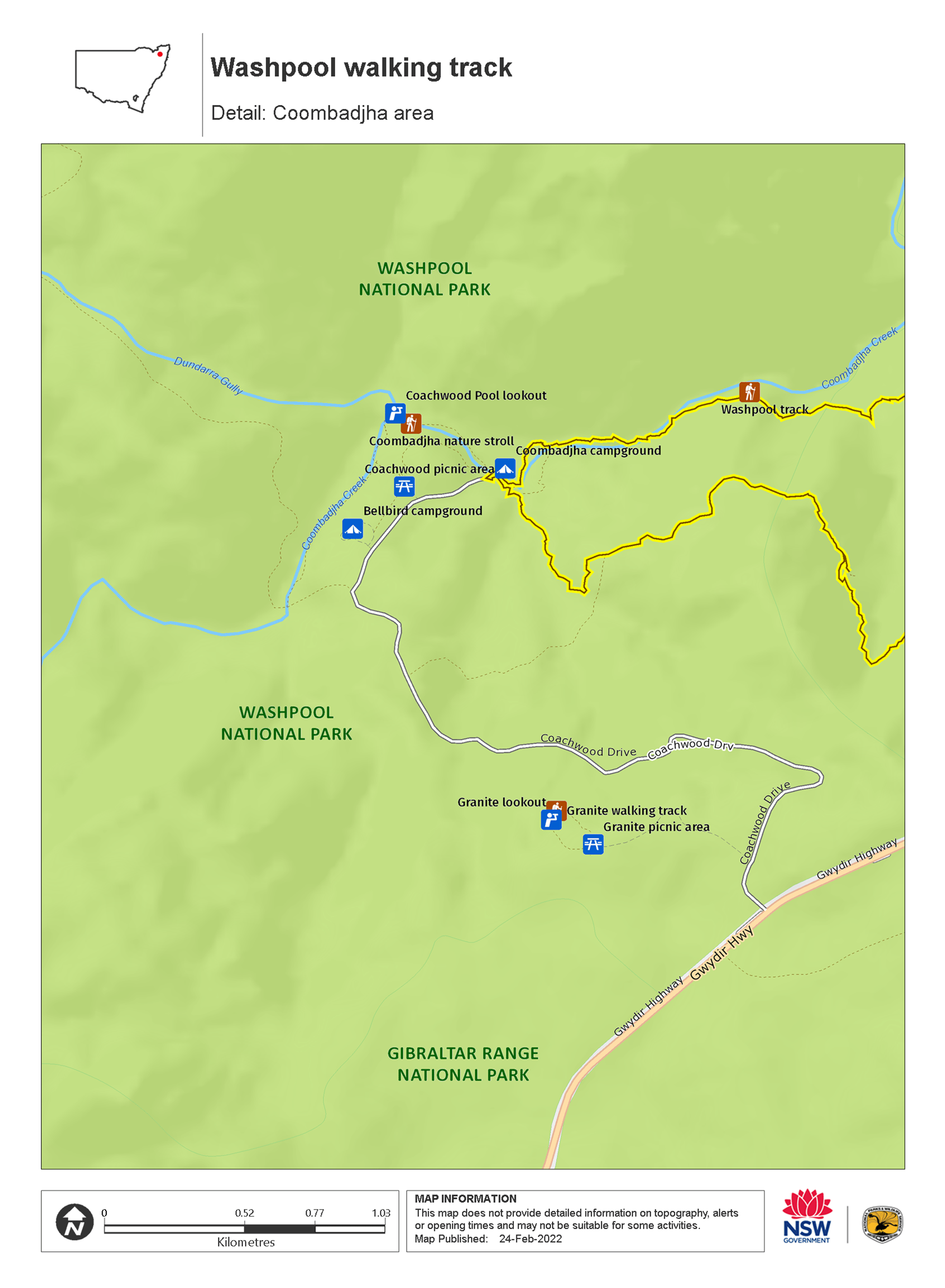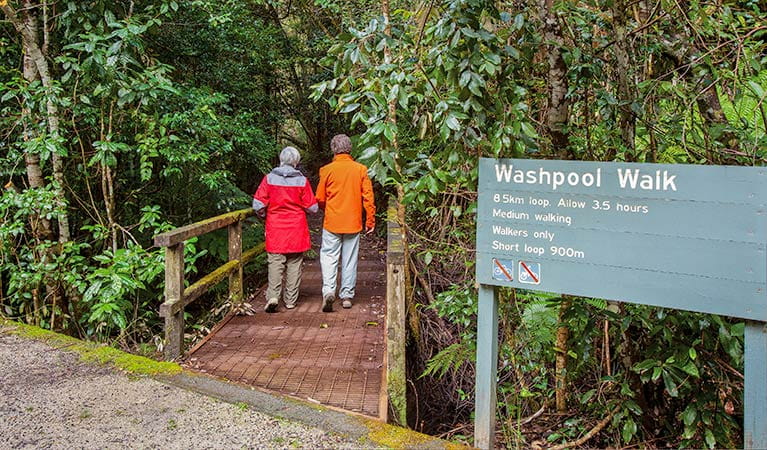Washpool walking track
North Coast, Country NSW
Overview
Revel in the timeless wonder of ancient Gondwana Rainforest along Washpool walking track, and enjoy rare birdwatching and wildlife, in Washpool National Park, near Glen Innes.
- Distance
- 8.5km loop
- Time suggested
- 3 - 4hrs
- Grade
- Grade 4
- Entry fees
- Park entry fees apply
- What to
bring - Hat, sunscreen, drinking water
- Please note
- There is limited mobile reception in this park
- Remember to take your binoculars if you want to go birdwatching
Immerse yourself in the timeless wonder of the warm temperate forests of Washpool National Park, near Glen Innes. This moderately challenging loop offers the rare opportunity to experience the ancient stands of World Heritage Gondwana Rainforest. Leading from Coombadjha campground, it's an ideal hike for experienced walkers who enjoy birdwatching and wildlife spotting in pristine wilderness.
Winding through gentle hills, this clearly sign posted walking track leads to one of the largest stands of coachwood forest in NSW. You’ll see picturesque waterfalls and spectacular views, with a chance to spot rainforest locals such as satin bower birds and lyrebirds.
Summit Creek is a great spot for a break and the beautiful surrounds make for some superb nature photography. Picnic along the way or head back for a barbecue lunch at the campground, where you might be tempted to camp overnight.
Nearby
-

Coombadjha nature stroll
Coombadjha nature stroll in Washpool National Park is a short yet inspiring walk through World Heritage listed rainforest, with a delightful swimming spot at the end.
-

Coachwood picnic area
Enjoy a picnic surrounded by rainforest at Coachwood picnic area in Washpool National Park. It’s also the starting point for the Coombadjha nature stroll, a short walk.
-

Bellbird campground
Bellbird campground is a great base to explore the World Heritage surrounds of Washpool National Park. It offers caravan, camper trailer and tent campsites.
Map

Map

Map legend

Local alerts
For the latest updates on fires, closures and other alerts in this area, see https://www.nationalparks.nsw.gov.au/things-to-do/walking-tracks/washpool-walking-track/local-alerts
General enquiries
- National Parks Contact Centre
- 7am to 7pm daily
- 1300 072 757 (13000 PARKS) for the cost of a local call within Australia excluding mobiles
- parks.info@environment.nsw.gov.au
Park info
- in Washpool National Park in the North Coast and Country NSW regions
Washpool National Park is always open but may have to close at times due to poor weather or fire danger.
-
Park entry fees:
$8 per vehicle per day applies only at attractions in the Glen Innes area. The park uses a self-registration fee collection system. Please bring the correct change and display your receipt.
Buy annual pass.
- in Gibraltar Range National Park in the North Coast and Country NSW regions
Gibraltar Range National Park is always open but may have to close at times due to poor weather, road damage, or high fire danger.
-
Park entry fees:
$8 per vehicle per day. The park uses a self-registration fee collection system. Please bring the correct change and display your receipt.
Buy annual pass.
Visitor info
All the practical information you need to know about Washpool walking track.
Track grading
Features of this track
Distance
8.5km loop
Time
3 - 4hrs
Quality of markings
Clearly sign posted
Experience required
Some bushwalking experience recommended
Gradient
Short steep hills
Steps
Many steps
Quality of path
Rough track, many obstacles
Getting there and parking
Washpool Walk is in the Coombadjha precinct of Washpool National Park. To get there:
- The entrance to Washpool National Park is 75km east of Glen Innes and 85km west of Grafton on the Gwydir Highway.
- Drive down Coachwood Drive for 3km to Coombadjha campground, where the walk begins.
Parking
Parking is available at Coombadjha campground.
Best times to visit
Washpool National Park offers an exceptional visit all year round. You're sure to find a walk, tour, activity or attraction to appeal, regardless of the season. Here are some of the highlights.
Autumn
Autumn offers good weather for exploring the park during the day and is cool enough during the evenings to sit by the campfire.
Spring
Mid-spring is a fantastic time to head out on the inspiring World Heritage walk. The temperature is perfect and the heathlands, swamps and woodlands erupt in a colourful display of wildflowers including the striking Gibraltar waratah.
Summer
Enjoy the shade of the rainforest with a picnic and walk, and then cool off with a dip in Coombajdha creek's natural pool.
Winter
The coldest time of the year means that you may likely have the park to yourself – enjoy the solitude.
Weather, temperature and rainfall
Summer temperature
Average
14°C and 26°C
Highest recorded
39.8°C
Winter temperature
Average
2°C and 15°C
Lowest recorded
-8.9°C
Rainfall
Wettest month
January
Driest month
April
The area’s highest recorded rainfall in one day
254.8mm
Facilities
Water is limited or not available in this area, so it’s a good idea to bring your own for drinking and cooking.
Maps and downloads
Permitted
Fishing
Fishing from a boat, the beach, the rocks or by the river is a popular activity for many national park visitors. If you’re planning a day out fishing, check out these fishing and rock fishing safety tips.
Prohibited
Pets
Pets and domestic animals (other than certified assistance animals) are not permitted. Find out which regional parks allow dog walking and see the pets in parks policy for more information.
Smoking
NSW national parks are no smoking areas.
Learn more
Washpool walking track is in Washpool National Park. Here are just some of the reasons why this park is special:
An important legacy

Washpool National Park is part of the Gondwana Rainforests of Australia World Heritage Area, which includes forty parks and reserves stretching along the Great Escarpment from Barrington Tops in NSW to south east Queensland. The area has a long history of selective logging, dating back to the 1800s when the valuable red cedar trees drew timber cutters with bullocks, axes and crosscut saws. With the development of machinery, the increasing pressure to exploit these forests met strong protest action from conservation groups. Ultimately, the park was created in 1983 after a study found the area contained significant plant and animal populations that either weren't found anywhere else in the state or were not well protected in reserves.
Cultural connections

The Bundjalung, Ngarrabul and Gumbaingirri people have a long connection with the lands here; the area was once used as a route between the coast and the tablelands, and as a place to gather a range of resources, such as rainforest fruits.
Rare residents

A huge range of threatened and endangered species enjoy the sanctuary of Washpool's diverse habitats. It's a refuge for mammals including koalas, spotted-tailed quolls, parma wallabies and long-nosed potoroos. Washpool and Gibraltar Range National Park are also brimming with birdlife. Look out for the rare rufous scrub bird in the rainforest undergrowth and, if you're extra vigilant, the even rarer powerful owl, which inhabits the hollows of trees in tall open forest. One of the most intriguing of the Washpool's residents is the pouched frog, a rainforest-dependent species whose male rears young tadpoles in pouches on his flanks.
- Coombadjha nature stroll Coombadjha nature stroll in Washpool National Park is a short yet inspiring walk through World Heritage listed rainforest, with a delightful swimming spot at the end.
- Washpool walking track Revel in the timeless wonder of ancient Gondwana Rainforest along Washpool walking track, and enjoy rare birdwatching and wildlife, in Washpool National Park, near Glen Innes.
Walker's wonderland

Lush rainforest, tinkling streams, dramatic gorges and an impressive plateau environment at just over the edge of the Great Escarpment make Washpool a singularly spectacular walking destination. Stretch your legs on an expansive network of graded walking tracks, including the popular World Heritage walk (which links Gibraltar Range and Washpool National Parks) and part of National trail. Nature strolls and the half-day Washpool walk commence from the creekside Coombadjha campground and take you on a meander through the lost world of the surrounding rainforest.
- Coachwood picnic area Enjoy a picnic surrounded by rainforest at Coachwood picnic area in Washpool National Park. It’s also the starting point for the Coombadjha nature stroll, a short walk.
- Granite picnic area Enjoy a picnic at Granite picnic area in Washpool National Park. Stretch your legs on an easy walk to Granite lookout for views over the World Heritage-listed landscape.
Plants and animals protected in this park
Animals
-

Swamp wallaby (Wallabia bicolor)
The swamp wallaby, also known as the black wallaby or black pademelon, lives in the dense understorey of rainforests, woodlands and dry sclerophyll forest along eastern Australia. This unique Australian macropod has a dark black-grey coat with a distinctive light-coloured cheek stripe.
-

Common ringtail possum (Pseudocheirus peregrinus)
Commonly found in forests, woodlands and leafy gardens across eastern NSW, the Australian ringtail possum is a tree-dwelling marsupial. With a powerful tail perfectly adapted to grasp objects, it forages in trees for eucalypt leaves, flowers and fruit.
-

Superb lyrebird (Menura novaehollandiae)
With a complex mimicking call and an elaborate courtship dance to match, the superb lyrebird is one of the most spectacular Australian animals. A bird watching must-see, the superb lyrebird can be found in rainforests and wet woodlands across eastern NSW and Victoria.
-

Southern boobook (Ninox novaeseelandiae)
The southern boobook, also known as the mopoke, is the smallest and most common native owl in Australia. With a musical 'boo-book' call that echoes through forests and woodlands, the southern boobook is a great one to look out for while bird watching.
Plants
-

Black sheoak (Allocasuarina littoralis)
The black sheoak is one of a number of casuarina species found across the east coast of Australia and nearby tablelands. Growing to a height of 5-15m, these hardy Australian native plants can survive in poor or sandy soils. The barrel-shaped cone of the black sheoak grows to 10-30mm long.

